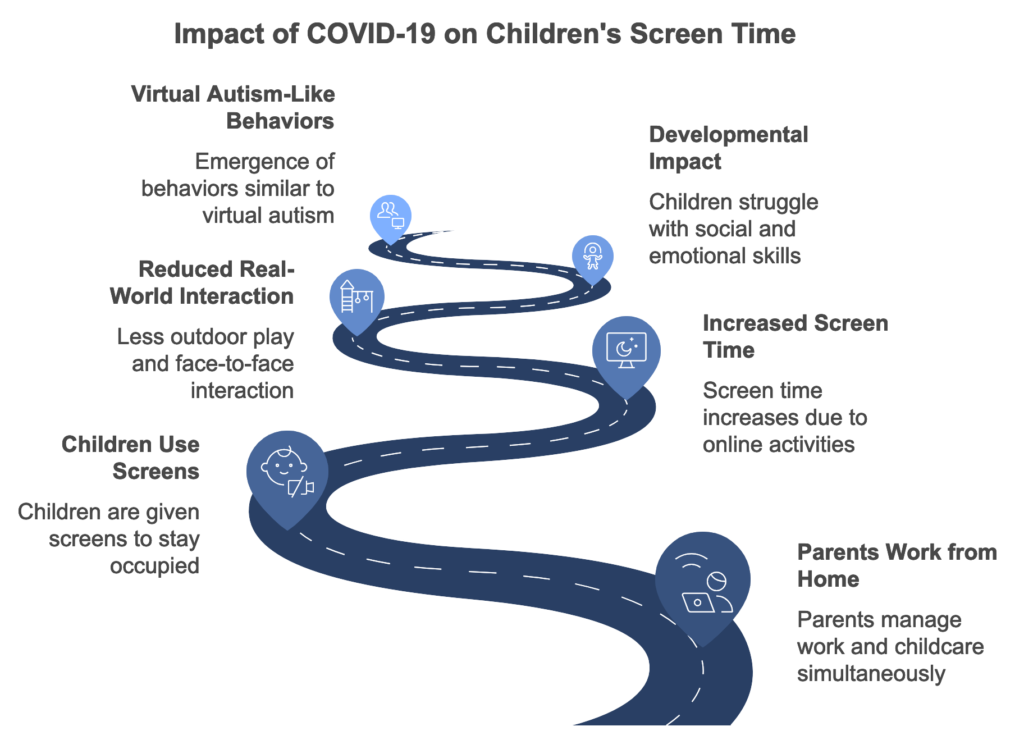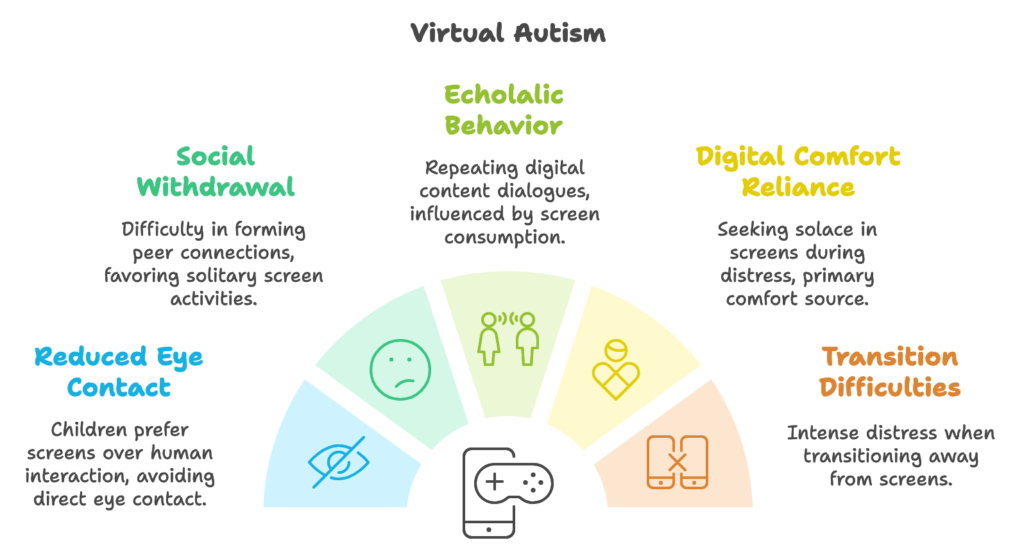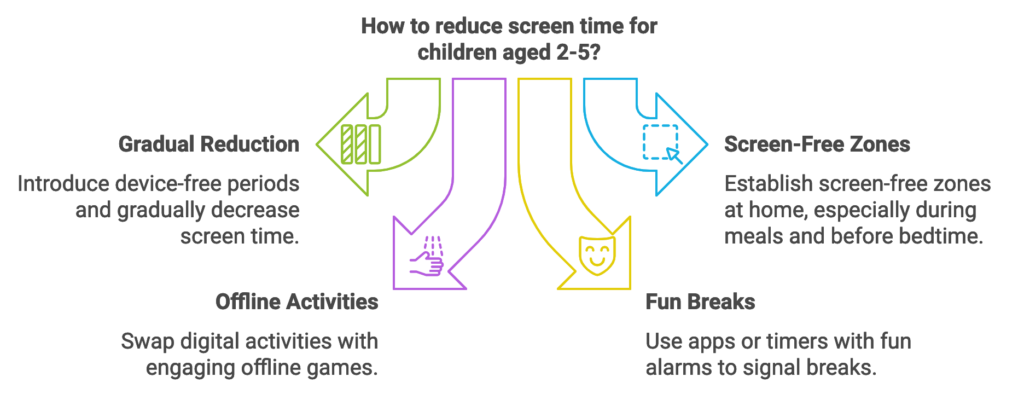
In today’s digital age, a growing number of parents and educators are observing behaviors in children that mirror those of Autism Spectrum Disorder (ASD). These symptoms, often linked to prolonged screen exposure and minimal real-world interactions, have been categorized under what experts now refer to as virtual autism.
Virtual autism isn’t a formal diagnosis recognized by medical organizations but represents a significant developmental concern for families and child development specialists alike. By understanding this condition, caregivers can better support healthy child development and prevent potential long-term impacts.
Virtual autism has become more prevalent due to shifts in family structures, technological advancements, and lifestyle habits shaped by contemporary culture. The COVID-19 pandemic, in particular, brought about an era where screen time became an unavoidable part of daily life, further complicating efforts to manage childhood development. This comprehensive guide will walk you through the scientific underpinnings of virtual autism, contributing factors, recognizable symptoms, intervention strategies, and preventive measures.
-
1. The Philosophical and Scientific Basis
Applied Behavior Analysis (ABA) Framework: Applied Behavior Analysis (ABA) provides a robust framework for understanding and addressing behavioral challenges, making it essential for differentiating between ASD and virtual autism. ABA emphasizes observable behavior and the environment’s influence on those behaviors, offering effective methods for intervention. For virtual autism, ABA can be a vital tool in assessing how screen time affects developmental progress and determining appropriate modifications to a child’s environment and daily activities.
Use a simple reward system to encourage activities like drawing, playing outside, or conversing with family members. This reinforces positive behavior while limiting screen dependence.
How the Brain Develops
A child’s brain is incredibly adaptable, especially during the first few years of life. This period is crucial because the brain is busy forming essential pathways to help with language, social skills, problem-solving, and emotional understanding. A child’s experiences during this time are key to shaping these pathways, so any activity or interaction—whether it’s speaking, playing, or observing—directly impacts how the brain grows and learns.

What Screen Time Does
Screens provide an intense and constant stream of stimulation. Whether it’s the flashing lights, fast-moving images, or the quick rewards from apps and games, screen time offers a level of excitement that real-life activities can’t easily match. This overstimulation causes the brain to release a lot of dopamine, the chemical associated with pleasure and reward, which can become addictive over time. As a result, the brain starts to crave that constant high level of stimulation, making everyday activities feel less engaging and harder to focus on.
-
Step-by-Step Effects on Development:
- Reward System Issues (Dopamine Dysregulation): Normally, children’s brains learn to find joy in everyday activities like playing with toys, interacting with people, or exploring their surroundings. These simple experiences help build their motivation and social connection. However, when children spend too much time on screens, the constant flow of dopamine from these digital experiences can cause their brain’s reward system to become overstimulated. Over time, this leads to difficulties in finding pleasure in slower, more thoughtful activities, such as reading, playing without a screen, or having a conversation. The brain starts to expect that same fast-paced excitement, which is not present in typical real-life experiences.
-
- Brain Plasticity Changes: Brain plasticity refers to the brain’s ability to adapt and create new pathways based on experiences. Normally, the brain strengthens its connections by interacting with the physical world and engaging in varied activities. These activities include talking with people, playing physical games, or problem-solving. But with excessive screen time, children’s brains become more adapted to the digital world, where everything is fast-paced and visually stimulating. As a result, the brain becomes less flexible and struggles to adjust to the slower, more subtle activities that are important for their development, like learning to solve problems, communicate, and build social relationships.

How These Changes Appear:
The impacts of excessive screen time can show up in various ways. One common effect is speech delays—children may not practice speaking as much when they’re absorbed in digital content, which reduces their chances of learning language. Without regular interactions with others, the brain doesn’t form the pathways it needs for fluent speech. Another effect is difficulty with social skills, such as maintaining eye contact or recognizing emotions in others.
These skills are built through real-world interactions, but if a child spends more time on screens, they miss out on those essential face-to-face moments. Additionally, emotional expression can be stunted because digital environments don’t require the same emotional intelligence and feedback that human interactions do. Children may find it harder to express their feelings or understand others’ emotions, since screens don’t provide the same cues as real people do.
Real-World Analogy:
Think of the brain like a well-worn path through a forest. The more a child uses a certain path, like talking or playing with others, the easier it is to walk that path. However, if a child spends most of their time on a fast, brightly-lit digital highway (the screen), the natural forest paths (real-world activities) become less familiar and harder to navigate. As a result, when it’s time to use those less-traveled paths, such as engaging in social interactions or focusing on a non-digital task, the child may struggle because the brain hasn’t had enough practice developing those skills.
In summary, excessive screen time can overload a child’s brain with intense digital stimulation, making it harder for them to enjoy and succeed in slower, real-world experiences. This overstimulation impacts the brain’s reward system and reduces its ability to learn and adapt in the way it needs to for healthy development. As a result, children may face challenges with speech, social interactions, and emotional expression.
Replace excessive screen time with engaging activities that stimulate the same dopamine response, such as puzzles, crafts, or active play. This helps maintain brain stimulation without digital devices.

2. Causes and Modern Lifestyle Contributions
Family Life Changes
In recent years, family structures have undergone significant changes. Traditionally, families had one parent at home while the other worked, allowing children to spend more time with a parent or guardian. However, today it’s more common for both parents to be working full-time, which leaves them with less time to directly interact with their children. This shift reduces the opportunities for parents to engage in activities like play, conversations, or teaching moments that are essential for a child’s development.
Lack of Interactive Play
Play is not just a fun activity for children—it is essential for their growth. Through play, children develop vital skills like communication, problem-solving, empathy, and emotional understanding. However, with both parents busy, children may not get as much of this important, face-to-face interaction. Instead of playing with their parents, they might spend more time alone or with peers, missing out on valuable learning experiences that come from direct engagement with trusted adults.
The Role of Digital Devices
To fill the gap left by busy parents, many families turn to digital devices. Phones, tablets, and TVs offer an easy way to entertain children while parents focus on work or household tasks. While digital devices can keep children occupied, they don’t provide the same learning benefits as direct interaction with people. Children who spend too much time with screens may miss out on the critical development of social and emotional skills, as these devices rarely encourage meaningful social exchanges.
The Core Problem
At its core, the problem comes down to the need for human connection in a child’s early years. Children develop best when they have meaningful interactions with adults who guide them through social experiences. Digital devices, while useful in some ways, cannot replace the real, live interactions that children need to learn social cues, manage emotions, and develop empathy. The changes in family structure, along with the rise in screen time, are limiting these critical interactions, which can lead to behaviors similar to autism, as children struggle to develop these fundamental social skills.
Create a “device basket” where all family members store their devices during meals and interactions to promote focused attention and bonding.
Pandemic Influence in Virtual Autism :
During the COVID-19 pandemic, a lot of parents started working from home, which meant they had to juggle both their work and taking care of their children at the same time. Since they couldn’t always give their kids their full attention, many parents allowed their children to watch TV or play on mobile devices to keep them occupied while they worked. This helped parents avoid distractions and manage their work, but it also led to kids spending even more time on screens.
With school, playtime, and social activities moving online, kids were already spending a lot of time in front of screens. Adding TV and mobile use as a way to keep them busy only increased their screen time even more. And because parents were busy with work, they might not have had the time or energy to engage with their kids as much, like playing outside or having face-to-face conversations, which are important for their emotional and social development.
This lack of real-world interaction, combined with too much screen time, can make it harder for kids to develop key skills like communicating, focusing, and understanding social cues. As a result, some children may have started showing behaviors that are similar to “virtual autism”—such as difficulty interacting with others or seeming disconnected from their surroundings. This doesn’t mean the kids are actually autistic, but rather that the changes in their routine and too much time spent on screens may have temporarily affected their development.
In summary, because parents were busy working from home and children spent more time with screens (TV, mobile, and online school), the lack of real-world interaction and physical activity made it harder for some kids to develop social and emotional skills, leading to behaviors similar to virtual autism.
.Use “micro-breaks” to pause online activities and involve children in physical movement, like jumping jacks or dancing to a favorite song, every 30 minutes during virtual learning. This prevents children from zoning out and builds healthy screen habits.

Links to Broader Lifestyle Choices:
Virtual autism does not exist in isolation from other lifestyle habits. Poor nutrition, characterized by the consumption of processed or “junk” food, can contribute to irritability and fluctuating energy levels, impacting cognitive function. Coupled with excessive screen use and a sedentary lifestyle, this combination can further compound developmental delays. The lack of physical activity and reduced social interactions create an environment where children are less likely to develop healthy communication and behavioral skills.
Integrating healthier diet options and physical play can help mitigate some of these risks. Introduce “screen-time snacks” that require preparation, such as making fruit skewers or arranging healthy snacks on a plate. This engages children in non-digital activities while promoting nutritional habits that support cognitive function.

3. Recognizing Virtual Autism: Signs and Diagnostic Guidelines
Symptoms Overview: Imagine you have a child who spends a lot of time playing video games, watching YouTube, or using their tablet. Because of this, they might start to act in ways that seem similar to autism,
Recognizing these symptoms is paramount for effective virtual autism therapy. Here’s a detailed look into the symptoms and indicators of virtual autism:
-
- Reduced Eye Contact: Just like with traditional ASD, children exhibiting virtual autism may avoid direct eye contact. They might seem more at ease gazing at screens than into the eyes of another person. This avoidance can stem from a preference for digital stimuli over human interaction.
- Social Withdrawal: These children might find it difficult to forge connections with peers, often preferring solitary activities involving screens. They may seem distant, disinterested, or even unaware of the presence of others around them.
- Echolalic Behavior: Echoing or repeating dialogues from TV shows, video games, or other digital content is common. While echolalia is also found in traditional autism, in the context of virtual autism, it’s heavily influenced by digital content consumption.
- Over-reliance on Digital Stimuli for Comfort: In moments of distress or discomfort, these children might seek solace in screens. Their primary source of comfort becomes the digital world, be it a favorite game, show, or app.
- Difficulty in Transitioning Away from Screens: Transitions can be hard. A child with virtual autism might exhibit distress, tantrums, or resistance when asked to stop using a device, much more intense than the usual reluctance many kids might show.
- Limited Imaginative Play: Unlike typical children who engage in diverse imaginative play, these kids might limit their imaginative scenarios to themes from the digital content they’ve consumed. For instance, they might only want to enact scenes from a specific cartoon or game.
- Sensory Over-sensitivity: A heightened sensitivity to sounds, lights, or even touch, mirroring traditional autism. This could be due to the overstimulation screens often provide, making real-world stimuli seem overwhelming.
- Delayed Speech or Communication Challenges: While engrossed in screens, opportunities for meaningful verbal interaction might be scarce, leading to potential delays in speech or challenges in effective communication.
- Repetitive Behaviors Focused on Digital Themes: This can include mimicking a specific animation repeatedly. Insisting on watching the same clip continuously, or even obsessively discussing a particular game or digital character.
- Sleep Disturbances: As mentioned earlier, excessive screen time, especially before bedtime, can interfere with melatonin production, leading to disrupted sleep patterns.
This is what’s called “virtual autism.” It’s like a shadow of traditional autism, but it’s not the same thing. The good news is that if you limit the child’s screen time and encourage them to play with friends, and family, or do other activities, these behaviors tend to get better.
Think of it like this: Traditional autism is like a permanent address, but virtual autism is like a temporary visit. If you change the environment (reduce screen time), the child can go back to being themselves.
To make it clearer:
- Traditional autism is a lifelong condition that needs special care and support.
- Virtual autism is a set of behaviors that can be changed by reducing screen time and encouraging more social interaction.
Keep a daily log of your child’s activities, noting behaviors during screen and non-screen times. This helps identify patterns and measure improvements when making lifestyle changes.

Differentiation from ASD:
Parents and practitioners must differentiate between ASD and virtual autism. While both conditions share similar symptoms, the key difference lies in the potential for reversibility. Children who display signs of virtual autism often improve markedly when screen time is limited, and direct human interaction is increased.
Parents can use observation checklists to monitor changes over time, tracking language use, social engagement, and eye contact during non-digital interactions.
Checklist for Parents:
- Note if your child meets basic developmental speech and social interaction milestones.
- Track daily screen time, identifying what type of content is most consumed.
- Observe and compare your child’s behavior during digital and non-digital activities.
Use a “reverse countdown” method where you set a timer before screen time begins and provide verbal reminders every few minutes as it winds down. This prepares children mentally for the transition and makes it easier to shift to other activities.
4. Early Intervention and Management Strategies
Reducing Screen Time: Reducing screen exposure is one of the most effective interventions for virtual autism. Experts, including the American Academy of Pediatrics, recommend that children aged 2-5 should not exceed one hour of screen time per day, and content should be of high-quality
Parents can implement gradual reductions in screen use, introducing device-free periods throughout the day. Establishing screen-free zones at home, particularly during meals and before bedtime, can create positive habits that extend beyond early childhood.
Simple steps like establishing device-free zones, especially during meals and before bedtime, can make a significant impact. Parents should gradually decrease screen time rather than abruptly eliminate it to avoid pushback and anxiety.
Swap digital activities with equally engaging offline games, like building blocks or scavenger hunts.
Use apps or timers with fun alarms to signal breaks, making it part of the child’s routine rather than a sudden change.

Promoting Real-World Interactions:
Physical and social activities should take center stage in a child’s daily routine. Encouraging interactive playdates, outdoor games, and structured family activities can foster engagement and social development. Activities such as storytelling, role-playing, and interactive reading sessions not only enhance language skills but also build stronger parent-child bonds
Plan interactive storytime sessions where children act out characters or use puppets. This can significantly boost language skills and emotional expression.
Case Study: Lucas, a 4-year-old, began to exhibit decreased speech and avoided eye contact after months of heavy screen time. His parents implemented a structured plan that limited digital exposure and incorporated story-based activities, like reading and family role-playing. Within weeks, Lucas showed marked improvements in verbal interaction and attention span
Include themed days for activities like “Nature Exploration Day” or “Arts and Crafts Afternoon” to make non-screen time exciting.
5. Preventive Measures
Proactive Parenting and Education: The idea behind proactive parenting and education is that parents should take steps before any problems start to make sure their kids have a healthy relationship with screens, like phones, tablets, or computers. It’s about being ahead of the game rather than just reacting when there’s already an issue.
What does this mean in simpler terms?
- Learn About Screen Time Risks: Parents should take the time to learn about how too much screen time can affect their kids’ health, behavior, and learning. For example, too much screen exposure can lead to issues like poor sleep, trouble focusing, or even mood changes.
- Balanced Digital Use: This isn’t about taking away screens completely but finding a good balance. Parents should figure out how to include screen time in a way that doesn’t interfere with other important activities like playing outside, doing homework, or spending time with family. It’s like making sure there’s a good mix of activities in a child’s daily routine.
- Create a Plan: Once parents know the risks and benefits, they can create rules or guidelines for screen use that fit their family. For example, setting “no screens at the dinner table” or having “device-free” hours before bedtime.
Overall, this is all about parents being informed and intentional with how their kids use technology, so it supports healthy habits instead of causing problems.
Look for online communities and webinars that guide maintaining balanced screen habits. This builds a support system for parents facing similar challenges
Modeling Behavior: Children often mirror the behavior of adults, making it essential for parents to exhibit mindful screen habits. By limiting their own device use, especially during family time, parents set an example for their children to follow. Creating a family screen-use plan where all members commit to tech-free periods can strengthen these habits. Use a color-coded schedule on the refrigerator to show when screen time is allowed and when it’s device-free time. This visual aid helps children anticipate and adhere to the routine.
SUGGESTION: Start with short, tech-free time blocks and gradually expand them to larger parts of the day. This allows children to adjust while learning the importance of balanced engagement.
Although virtual autism is not officially recognized as a medical diagnosis, its behavioral patterns are significant enough to warrant attention from parents and healthcare providers. It’s essential to view it as a developmental concern that requires targeted intervention
Consult with developmental specialists who are aware of the implications of screen time to get a more informed perspective on potential virtual autism
Virtual autism often responds positively to early intervention. When parents and caregivers take deliberate steps to reduce screen time and replace it with engaging in-person activities, children typically show improvement. This reversibility differentiates it from traditional ASD, where symptoms may be lifelong despite intervention
Create a weekly “Progress Chart” that celebrates small achievements, like learning new words or making eye contact. This not only encourages the child but keeps parents motivated to stay consistent.
Virtual autism is a pressing concern as digital devices become central to everyday life. While technology is beneficial in many ways, excessive use without moderation can impact child development. Understanding the factors contributing to virtual autism, recognizing its symptoms, and applying intervention strategies rooted in applied behavior analysis and real-world interaction are vital for nurturing healthy growth in children. By balancing screen time and encouraging active play, parents and educators can create environments that support cognitive, social, and emotional development.
If you observe signs of virtual autism in your child, consult with specialists in child development or ABA therapist. Early action and consistent effort can make a significant difference, leading to a healthier developmental path
Resources
- Autism Support Group : https://www.facebook.com/groups/SupportAutism
- Youtube Podcast : https://www.youtube.com/@BeChangeCenter
- Autism Speaks: www.autismspeaks.org
- Behavior Analyst Certification Board (BACB): www.bacb.com
- National Autism Association: www.nationalautismassociation.org
